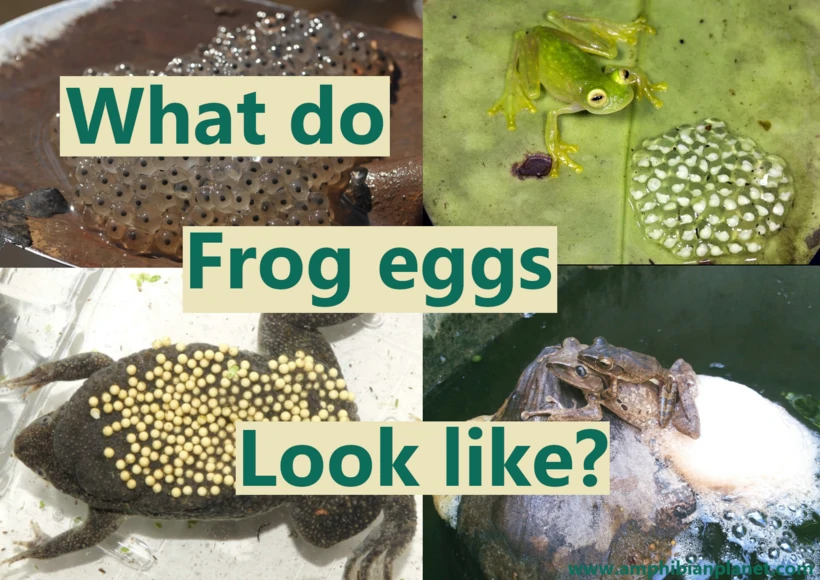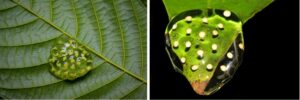When the winter ends, and the warm and wet spring weather comes, frogs emerge from hibernation and migrate to ponds to mate and lay their eggs. But what do frog eggs look like?
Most frogs lay eggs in the water. Frog eggs laid in the water look like a clump of clear jelly-like globs, with a developing embryo visible inside each egg. The embryos can appear as black, brown, or even cream-ish yellow dots inside each egg. Masses of many frog eggs stuck together are collectively called “frogspawn”.
Some tree frogs, like the red-eyed tree frog, do not lay eggs in the water. Instead, they lay eggs on leaves over streams or other water bodies. The tadpoles fall into the water below once they hatch.
Most Frogs Lay Their Eggs in the Water
On the first rainy night of spring, when the temperatures are hovering around 40-50°F, thousands of frogs and salamanders emerge from their overwintering spots and migrate to breeding ponds. This mass migration is often referred to as “the big night”.
In some towns, people close roads and gather to watch thousands of frogs and salamanders on their breeding migration.
During this migration, frogs can travel significant distances, sometimes up to half a mile to reach deep enough pools of water where they can lay their eggs.
This could be marshes, ponds, swamps, bogs, lake edges, roadside ditches, or even deep tire tracks. However, many frog species prefer to breed in something called “Vernal pools ”

Vernal pools are temporal pools of water that form in the spring. They are formed when depressions on the ground are filled with water from melting snow and falling rain.
They are typically small and shallow, and unlike a pond or lake, they have no permanent source of water. This means they dry up in the summer.
Since they are temporal, they do not have fish that could eat the eggs before they hatch. This makes them ideal amphibian breeding sites.
What Frog Eggs Laid in the Water Look Like
Once in the water, the frogs will mate, and the eggs will be fertilized, usually externally; the female releases her eggs from her body into the water – and the male releases his sperm to fertilize the egg as the female lays them.
When laid, the egg masses are attached to twigs or other vegetation slightly below or on the water’s surface. If the pool has lots of emergent vegetation, eggs are often laid in open areas which receive lots of sunlight.
Depending on the species, each egg mass can have anywhere from 30 to as many as 1500 eggs.
Here Is What Frog Eggs laid in the water Look Like:
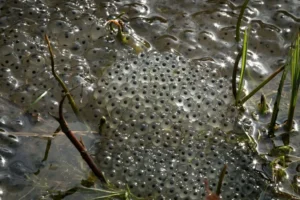


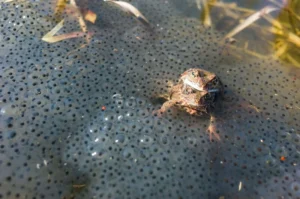
When first laid, frog egg masses are very dense and tightly packed together. Over time, the jelly of eggs absorbs water, which causes the egg mass to swell in size.
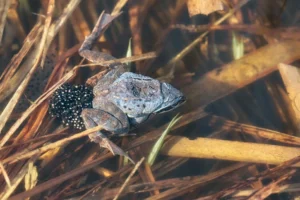
Although frog egg masses are usually clear, they can be slightly different colors depending on the frog species. They may be cloudy-white cream-colored, have a tint of brown, or yellow, or even have a green glow from algae.
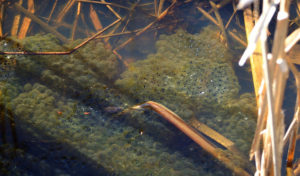
The jelly holds the eggs together and protects the developing embryos from the elements. It also acts as a “shock absorber” to prevent injury to the egg from the water movement.
When submerged in the water, frog eggs will look bubbly and bumpy.

American Bullfrogs and Green Frogs Lay Their Eggs as a Thin Sheet
Unlike most frogs, green frogs and American bullfrogs do not lay eggs in tight masses. Rather, their eggs are laid in a loose mass draped on underwater plants, slightly below the water’s surface.

After about a day, the egg cluster floats to the water surface and flattens out into a giant thin sheet, only about one or two eggs thick.

What Do Frog Eggs Look Like Before They Hatch?
When frogs are close to hatching, well-developed tadpoles are visible inside each egg. The egg masses usually loosen up and lose their shape, which makes them look like a film on the surface of the water. Sometimes, they may even become green with algae.
Here is what frog eggs look like before they hatch:


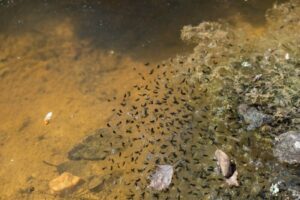
This frog egg mass has lost its shape and flattened out on the water. Well-formed tadpoles are visible inside the jelly.
Some Frogs Lay Eggs on Leaves Overhanging Water
Some frogs such as the red-eyed tree frogs, and glass frogs do not lay their eggs in water. Rather, they lay them on leaves that hang over a pond.
When the eggs are ready to hatch, the tadpoles inside start wriggling around, breaking the eggs open. The tadpoles then wash down the leaf and fall into the pond below.
Laying eggs this way protects them from lots of predators, both and land and in the water.
Here is what frog eggs laid on leaves look like :

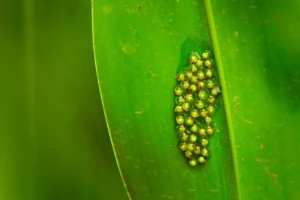
Some Frogs Lay Eggs in Bubble Nests
Frogs such as the gray foam-nest tree frog of southern Africa and the Fourlined tree frog of Southeast Asia lay their eggs in a foam “nest”. This nest is built on branches or leaves overhanging a pond.
During the mating process, the female frogs produce an oviduct secretion. This secretion is then whipped up by the female, and the attending male’s hind legs to create a froth in which the eggs are laid and fertilized. The froth dries with a meringue-like crust to protect the eggs.
After about a week, the eggs will hatch and tiny tadpoles will wriggle down the foamy secretion and plop into the water below.
Here is what the eggs of foam nest tree frogs look like:

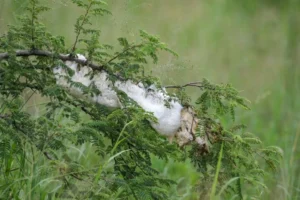
Some Frogs Lay Eggs on Land
Some frogs, such as the Walpole Frog of Australia lay eggs on land. The eggs are laid in a small cluster in wet soil, or moss burrows hidden by vegetation near creeks, swamps, and other freshwater bodies.
When the tadpoles hatch, they never swim or come in contact with water. Instead, they develop inside the broken egg jelly mass, feeding entirely on the yolk of their egg – until they develop into small frogs.
What the Eggs of Aquatic Frogs Look Like
Fully aquatic frogs like the African dwarf frog, and the African clawed frog lay sticky eggs that look like tiny white beads. These eggs stick to stones, sticks, or other surfaces over time. A single frog can have anywhere from 500 to 2000 eggs in a single breeding season.
The eggs can be densely packed in a large single mass, in small masses, or even singly, and are spread on surfaces in the water.
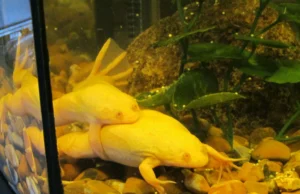

What Do Tree Frog Eggs Look Like?
In general, the eggs of most tree frogs that lay eggs in the water look just like those of other frogs. However, some tree frogs like the Pacific tree frog lay eggs in small jelly packets, which makes them look different from the eggs of most other frogs.
Here is what the eggs of a few tree frogs look like:
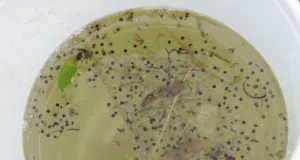


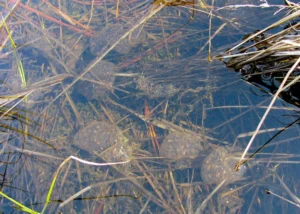

Poison Dart Frogs Have a Unique Breeding Strategy
Most frogs lay their eggs in water or attach them to plants that are hanging over the water. However, this is not the case for dart frogs.
These frogs often live in highly forested areas without many sources of permanent water, so they had to develop a unique breeding strategy.
A female dart frog will lay her eggs in a burrow or sometimes under a leaf. The eggs are in a cluster and have a jelly-like sac surrounding them.
Once the eggs are deposited, the male frog fertilizes them (externally) and remains with them until they hatch. Once the eggs hatch, the mother returns, and the tadpoles wiggle their way onto her back.

She then transports them to suitable pools of rainwater that have accumulated between the leaves of bromeliad plants. The tadpoles will then swim around in the water and after a while, develop into young frogs.
Here is what the eggs of poison dart frogs look like:
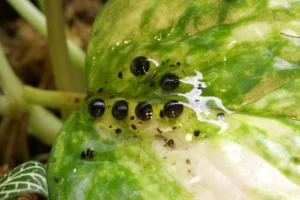
What Toad Eggs Look Like
Unlike true frogs, toads do not lay their eggs in masses. Rather, toad eggs are laid in long strings (one to three eggs wide) along plants or on the bottoms of shallow water in ponds. The eggs are covered in jelly and look almost like jelly-coated necklaces.
Sometimes sediment settles on toad egg masses, covering individual eggs and making them look like giant worms!
A single toad can lay anywhere from 2,000 to over 18,000 eggs in a single breeding season, depending on the species.
Here is what toad eggs look like:
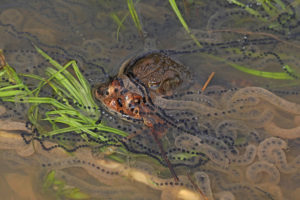


Frog Eggs vs Salamander Eggs
Frogs and salamanders usually lay eggs in the same pools. Since these egg masses look very similar to each other, they can be difficult for the untrained eye to tell apart.
It is possible to mistake salamander eggs for frog eggs, and vice versa.
Here is how you can tell frog eggs from salamander eggs:
1. Appearance
The easiest way to tell frog eggs from salamander eggs is to look at the outer layer of the egg mass. Salamander egg masses are surrounded by a jelly coat, but frog egg masses are not.
If you took a close look at a frog egg mass, you would easily notice the contour of each individual egg on the outer layer of the egg mas. This contour gives frog egg masses a bumpy surface, sort of like a cluster of grapes.

On the other hand, if you looked at a salamander egg mass, you wouldn’t see the contour of the eggs on the outer layer, since the entire egg mass is covered in an outer layer of jelly.
The surface of the egg mass would look smoother and more uniform. However, if you looked very closely into the jelly, you would see the outline of each egg within the mass.
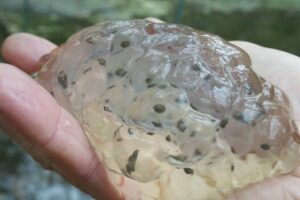
When floating on the surface of the water, frog eggs will look bubbly and bumpy, while salamander eggs will look like blobs of jelly with eggs visible inside.
On the frog egg mass, you can see the contour of the eggs on the outer part of the mass even when submerged in water. The outline of the outer layer of jelly is visible even on the submerged salamander eggs.
2. Texture
Another difference is that salamander eggs tend to be firmer and denser than frog eggs. If you were to gently poke at a salamander egg mass, it would meet your finger with resistance, while a frog egg mass would feel loose and give in to the slightest pressure.
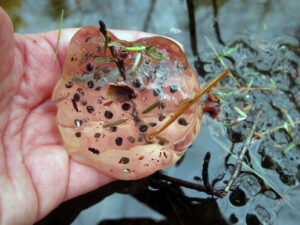
Also, if you were to pick up a salamander egg mass, it would hold its shape even out of water. However, if you picked up frog egg mass, it would be looser and the eggs would fall apart more easily.
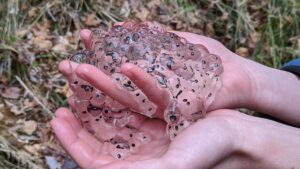
twig suspended above the water.
Even the eggs of Pacific tree frogs which look very similar to salamander eggs have a very loose consistency and do not hold their shape out of water.
Here is what the eggs of a Jefferson salamander look like next to those of a wood frog.
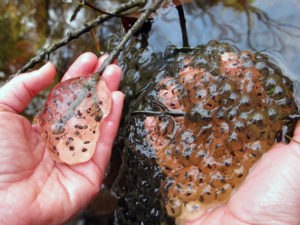
The Weirdest Frog Eggs
With over 5,000 species of frogs and toads in the world, there are bound to be a few that stick out as being weird.
Here are a few frogs with weird breeding strategies (and eggs).
1. Horned Marsupial Frog
Horned marsupial frogs are found in Colombia, Costa Rica, Ecuador, and Panama. These frogs breed by direct development, which means they do not have a free-living tadpole stage.
The female frog releases eggs from her body, which the male then fertilizes, and deposits in a pouch on the female’s back. She then carries the eggs around – which full hatch as fully developed frogs.
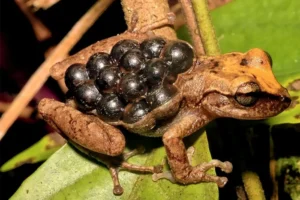
2. Banded Horned Tree Frog
Like the horned marsupial tree frog, the eggs of Banded horned tree frogs are carried in a pouch on the mother’s back and hatch into fully developed frogs.

Banded horned tree frogs are found in northwestern Ecuador.
3. Surinam Toad
Suriname Toads are a fully aquatic frog species from the northern Amazon basin of South America. These frogs are unique, in that the female gives “birth” to the young out of her back!
The female releases about 100 eggs during mating. Next, the male fertilizes the eggs and pushes them into the female’s back. The skin of the female then encloses the eggs – and the eggs stay on her back for three to four months.
Once the eggs hatch, fully formed frogs will pop out of the female’s back.
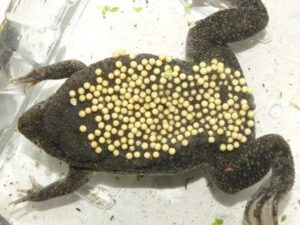
Not All Frogs Lay Eggs
While most frog species lay eggs, there are a few exceptions. For example, Limnonectes larvaepartus, a species of fanged frog found in northern and western Sulawesi, Indonesia – does not lay eggs and instead gives birth to live young.
Females produce approximately 100 eggs. The embryos then develop inside their eggs inside the mother’s body and hatch into well-developed tadpoles just before birth.
Finally, the tadpoles are birthed into slow-moving streams where they will develop into froglets.
Frequently Asked Questions (FAQS)
What do land frog eggs look like? Most land frogs lay eggs in the water. Their eggs look like a clump of clear jelly-like globs, with a developing embryo visible inside each egg. The embryos can appear as black, brown, or even cream-ish yellow dots inside each egg.
What do tree frog eggs look like? Most tree frog eggs laid in the water look just like those of other frogs. Some tree frogs, such as pacific tree frogs, lay their eggs in small jelly packets, and other tree frogs like the spring peeper lay their eggs in rows attached to submerged vegetation.
What do frog eggs look like before they hatch? When frog eggs are about to hatch, the egg mass usually loosens up and loses its shape, which makes it look like a film of the water’s surface – and well-developed tadpoles are visible inside individual eggs of the egg mass. Sometimes, the egg mass may even become green with algae.

